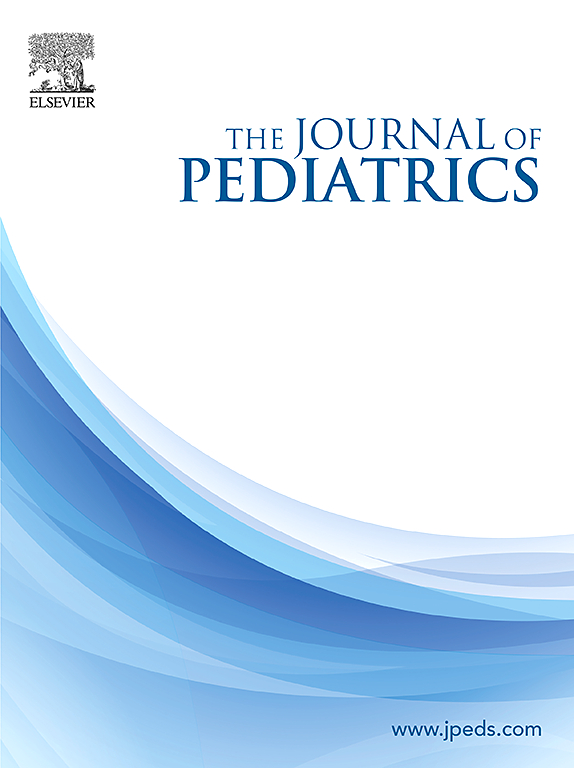In Utero Exposure to Gestational Diabetes and Child Health at Age Three to Seven: A Cohort Study
IF 3.9
2区 医学
Q1 PEDIATRICS
引用次数: 0
Abstract
Objective
To determine if, after adjusting for potential confounders, child health outcomes differ between children exposed to maternal gestational diabetes mellitus (GDM) and their unexposed peers.
Study design
Prospective cohort study. Recruitment took place between June 2022 and May 2024. The primary outcome was overweight or obesity. The secondary outcomes were other measures of size, eating behavior, behavioral and emotional problems, neurodevelopmental disorders, atopic disorders, and diabetes. Between-group differences were determined with generalized linear mixed models adjusted for gestational weight gain and socioeconomic status.
Results
Of the 699 children who participated at a mean age of 5.6 years, 295 (42.2%) were exposed to GDM. There was no difference in the risk of being overweight or obese in children exposed to GDM compared with those unexposed (adjusted relative risk [95% CI]: 0.69 [0.44, 1.08]). Children exposed to GDM had lower body mass index z scores (adjusted relative risk [95% CI]: −0.30 [−0.53, −0.60]), enjoyment of food scores (adjusted relative risk [95% CI]: −0.17 [−0.31, −.04]), and risk of abnormal hyperactivity scores (adjusted relative risk [95% CI]: 0.23 [0.06, 0.87])] Other outcomes were similar between exposure groups.
Conclusions
After accounting for confounders, children exposed to treated GDM had a risk of being overweight or obese comparable with their unexposed peers. Our findings are reassuring for parents and health practitioners caring for women who experience GDM and their children.
子宫内暴露于妊娠期糖尿病与3至7岁儿童健康:一项队列研究
目的:确定在调整潜在混杂因素后,暴露于母体妊娠期糖尿病(GDM)的儿童与未暴露于GDM的儿童之间的儿童健康结局是否存在差异。研究设计:前瞻性队列研究。招聘在2022年6月至2024年5月期间进行。主要结局是超重或肥胖。次要结果是其他测量尺寸、饮食行为、行为和情绪问题、神经发育障碍、特应性疾病和糖尿病。组间差异通过调整妊娠体重增加和社会经济地位的广义线性混合模型确定。结果:699名平均年龄5.6岁的儿童中,295名(42.2%)暴露于GDM。与未暴露于GDM的儿童相比,暴露于GDM的儿童超重或肥胖的风险没有差异(aRR [95% CI]: 0.69[0.44, 1.08])。暴露于GDM的儿童BMI z评分(aRR [95% CI]: -0.30[-0.53, -0.60])、食物享受评分(aRR [95% CI]: -0.17[-0.31, - 0.04])和异常多动风险评分(aRR [95% CI]: 0.23])较低。暴露组之间的其他结果相似。结论:在考虑混杂因素后,暴露于治疗过的GDM的儿童与未暴露的同龄人超重或肥胖的风险相当。我们的研究结果让照顾患有GDM的妇女及其子女的父母和健康从业人员放心。
本文章由计算机程序翻译,如有差异,请以英文原文为准。
求助全文
约1分钟内获得全文
求助全文
来源期刊

Journal of Pediatrics
医学-小儿科
CiteScore
6.00
自引率
2.00%
发文量
696
审稿时长
31 days
期刊介绍:
The Journal of Pediatrics is an international peer-reviewed journal that advances pediatric research and serves as a practical guide for pediatricians who manage health and diagnose and treat disorders in infants, children, and adolescents. The Journal publishes original work based on standards of excellence and expert review. The Journal seeks to publish high quality original articles that are immediately applicable to practice (basic science, translational research, evidence-based medicine), brief clinical and laboratory case reports, medical progress, expert commentary, grand rounds, insightful editorials, “classic” physical examinations, and novel insights into clinical and academic pediatric medicine related to every aspect of child health. Published monthly since 1932, The Journal of Pediatrics continues to promote the latest developments in pediatric medicine, child health, policy, and advocacy.
Topics covered in The Journal of Pediatrics include, but are not limited to:
General Pediatrics
Pediatric Subspecialties
Adolescent Medicine
Allergy and Immunology
Cardiology
Critical Care Medicine
Developmental-Behavioral Medicine
Endocrinology
Gastroenterology
Hematology-Oncology
Infectious Diseases
Neonatal-Perinatal Medicine
Nephrology
Neurology
Emergency Medicine
Pulmonology
Rheumatology
Genetics
Ethics
Health Service Research
Pediatric Hospitalist Medicine.
 求助内容:
求助内容: 应助结果提醒方式:
应助结果提醒方式:


